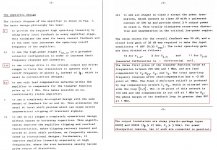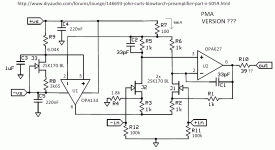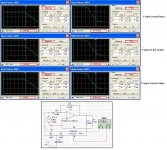Scott, I don’t disagree on what you say in both of your posts, especially with the “base charge storage that would contribute phase in a distributed fashion”.
But then look at their Fig. 8. Phase compensation is distinct from the fixed -frequency independent- delay compensation element.
I would say they didn’t try a simplification here. I suspect a fundamental disagreement around the ‘f word’ (their page 6 'i' para ?).
George
They say in caption, phase compensation is only approximate, they wanted an extra 55 deg at 1MHz. Well the delay is that (with phase wiggles left because the path through the amp is not a true delay). Remember they are only looking at the error signal at 20kHz max. I suspect picking an RC for 100deg at 1MHz and dumping the 150ns would have made a trivial difference, this is after all the distortion "magnifier" principle.
Question - the 470 Ohms and 680 pF is at 500kHz, how does R2 contribute to the phase when it is in series with 39K to the output?
Last edited:
how does R2 contribute to the phase when it is in series with 39K to the output?
Isn't the amp inverting, R6 contributing to the gain/phase since it's in the feedback loop? R1 defines the lowest closed loop gain at which the amp should be stable (that would be with the input open).
If memory serves, the output devices were quite fast for the day (they are relatively medium power, not the sluggish 2N3055-type high power devices). That's why there are 2 pairs for just 50W Pout.
I think they were 30MHz Ft devices.
jan
Jan, BD 203/204 were sold as 3 MHz devices, as most of the BD range is.
BD 139/140 is an obvious exception, I have seen them declared as 170 MHz capable devices, but they are "medium" power devices, 7W at best.
Later devices, such as BD 745/746 extended to 5 MHz nominal, but as far as I am aware, that's it.
@rayma
Well, what did you expect from a nominall 25/50W into 8/4 Ohms amp? A behemoth it was not, to be sure.
As for Citation II, as I said, right from the start H/K was a wide bandwidth company. In an interview, Dr Sidney Harman made it clear - he ran the business, and Bernard Kardon ran the technology side of it all. And B. Kardon was a true wide bandwidth man.
Well, what did you expect from a nominall 25/50W into 8/4 Ohms amp? A behemoth it was not, to be sure.
As for Citation II, as I said, right from the start H/K was a wide bandwidth company. In an interview, Dr Sidney Harman made it clear - he ran the business, and Bernard Kardon ran the technology side of it all. And B. Kardon was a true wide bandwidth man.
Last edited:
@Scott Wurcer
Come on, Scott, those were the early days, and they were 40 years ago. During the 70ies, we were learning in leaps and bounds.
Sure, mistakes were made, they may even appear to be naive today, but at the time, they were advancing the art in no small steps. Now, 40 years later, it sems obvious they were on the right track, but today, we take for granted what was big news back then.
Come on, Scott, those were the early days, and they were 40 years ago. During the 70ies, we were learning in leaps and bounds.
Sure, mistakes were made, they may even appear to be naive today, but at the time, they were advancing the art in no small steps. Now, 40 years later, it sems obvious they were on the right track, but today, we take for granted what was big news back then.
Attachments
Thanks Jan.
(The piano and I were born in the same year.I need renovation too!
Back in the 1970s-80s there was a second hand audio dealer in London called Dennis Trickett who always reckoned that the early Electrocompaniet Amp was the best sounding solid state amp available in the mid 80s! [I bought from him a brand new Precision Fidelity pre, an early Brauer PU arm and all sorts of rare bits and pieces, including broken SPU cartridges which the importer would back then replace with factory rebuilds for £30. Dennis also rebuilt Quad, Leak and any other tube amp to the highest quality………I would have loved for him to build a top quality Tube amp from scratch….but he died very young from a very fast spreading cancer].
Yes, I had a gold Breuer Dynamic 5A arm in the 70s, when they only cost about $500. It was very nicely made, and sounded pretty good, although it was somewhat warm and rich.
@ Jan Didden
All these years i've known about Matti Otala, but never heard of Jan Lohstroh until now. What a shame his name & contibutions wern't more widely publiced. Thanx for the interview PDF
That's what i thought too.
Yeah that's what it says in the latest PDF. "Maybe" they were better All those years ago ? I doubt it, but ?
For http://home.online.no/~tsandstr/AudioStartsHere.htm try this The Sandstrøm Audio Site
All these years i've known about Matti Otala, but never heard of Jan Lohstroh until now. What a shame his name & contibutions wern't more widely publiced. Thanx for the interview PDF
Originally Posted by Waly
Isn't the amp inverting
That's what i thought too.
Originally Posted by dvv
BD 203/204 were sold as 3 MHz devices
Yeah that's what it says in the latest PDF. "Maybe" they were better All those years ago ? I doubt it, but ?
For http://home.online.no/~tsandstr/AudioStartsHere.htm try this The Sandstrøm Audio Site
It happens sometimes, Zero D.
For example, Motorola/ON Semi's MJE 15030/15031 are sold as 30 MHz devices (drivers), but when you examine the Data Sheet, you discover that within the usable range as drivers, they will spend much of their time as 50+ MHz devices.
Also, many power devices are sold as "minimum XX MHz", so in practice, you may well find they do better than adverstised (and no, I am not taking any drugs).
For example, Motorola/ON Semi's MJE 15030/15031 are sold as 30 MHz devices (drivers), but when you examine the Data Sheet, you discover that within the usable range as drivers, they will spend much of their time as 50+ MHz devices.
Also, many power devices are sold as "minimum XX MHz", so in practice, you may well find they do better than adverstised (and no, I am not taking any drugs).
Isn't the amp inverting, R6 contributing to the gain/phase since it's in the feedback loop? R1 defines the lowest closed loop gain at which the amp should be stable (that would be with the input open).
I think Fig.8 shows the amplifier block including feedback G =~-38. The external network is a divider of ~38 tuned by the pot to give a null and show only the error. This only works well with a phase correction. In their figure the amp and input source are low impedance so by reduction there is only 1 time constant 470||(470 + pot + 39K) and 680pF which is added to the 150ns. See Bob Cordell's distortion magnifier.
Jan, BD 203/204 were sold as 3 MHz devices, as most of the BD range is.
BD 139/140 is an obvious exception, I have seen them declared as 170 MHz capable devices, but they are "medium" power devices, 7W at best.
Later devices, such as BD 745/746 extended to 5 MHz nominal, but as far as I am aware, that's it.
OK, thanks, I hadn't looked it up, so obviously I remembered incorrectly.
Jan
OK, thanks, I hadn't looked it up, so obviously I remembered incorrectly.
Jan
If memory serves, higher Ft devices began to appear in the second half of the 70ie, i.e. after the paper had been published in IEEE. NEC was very active, as was Sanken, but very soon, the rest of Japanese manufacturers joined suit.
RET transistors appeared in Pioneer amps in the late 70ies, but Sansui and Kenwood in particular already had very high slew rate amps on the market by then.
In the meanwhile most used what Nigel Pearson calls "Medium Ft power devices", from NEC and Hitachi in praticular, with ratings 8-20 MHz, in metal TO-3 packages mostly.
Scott,
Can you give some idea of the about the expected en noise performance of this circuit as drawn?
PMA,
Can you share your choice for U1?
Thanks,
Dave
Sorry for input.
I have tried to find too from here http://www.diyaudio.com/forums/atta...wtorch-preamplifier-part-ii-preamp_detail.jpg
Forgive me if it presents some absurd
Attachments
That system is in Frank Sinatra's Palm Springs home. Its still there. I saw it on a tour about a year ago. You can rent the place for a weekend if you want to be ultra cool.
This film on stereo is contemporary with the above system . . . https://www.youtube.com/watch?v=ziMw7uh9VNo
Fremer has some comments if you read through them.
I learned more from that video than what I learned from all the years over at ** Forum. ...And I'm not stressed at all but totally relaxed.
Last edited:
Ela, Yorgos, pass the ouzi!And the moussaka, and the giros!
At my age, I’d better quit the old lusts (eat late at night)
Question - the 470 Ohms and 680 pF is at 500kHz, how does R2 contribute to the phase when it is in series with 39K to the output?
I think Fig.8 shows the amplifier block including feedback G =~-38. The external network is a divider of ~38 tuned by the pot to give a null and show only the error. This only works well with a phase correction. In their figure the amp and input source are low impedance so by reduction there is only 1 time constant 470||(470 + pot + 39K) and 680pF which is added to the 150ns. See Bob Cordell's distortion magnifier.
Good point Scott
I tried to see the effect of the pot. Whether G is –38 or –32, the pot max effect is 0.09dB and 0.5Deg at 500kHz
George
Attachments
1audio,
With all that information from the Mr. Smith's I know everything I ever wanted to know about stereophonic sound! 20hz to 15Khz and you got it covered. Now I just need to find one of those RCA HiFi boxes and I'm all set. That was an interesting view of how simple things seemed to be, how far have we come since then?
With all that information from the Mr. Smith's I know everything I ever wanted to know about stereophonic sound! 20hz to 15Khz and you got it covered. Now I just need to find one of those RCA HiFi boxes and I'm all set. That was an interesting view of how simple things seemed to be, how far have we come since then?
- Status
- Not open for further replies.
- Home
- Member Areas
- The Lounge
- John Curl's Blowtorch preamplifier part II


